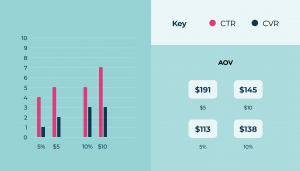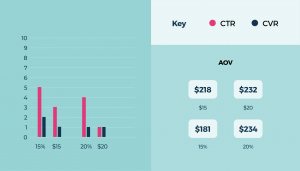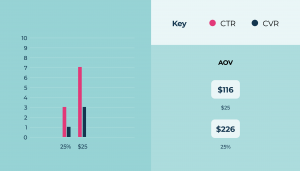By Simon Bird, Co-Founder and CEO, RevLifter
Words are arguably one of the most important parts of any promotion. Unfortunately, choosing which words to use often comes down to preferences rather than data.
Yes, there are branding considerations. I doubt Harvey Nichols or Versace will ever advertise a ‘Huge sale’, for example.
But away from the complex world of luxury goods, there are several widely applicable choices that most retailers have to make:
- Do you say ‘deal’ or ‘offer’?
- Do you say ‘buy now’ or ‘buy today’
- Should you show customers how much they save?
We at RevLifter thought this made for an interesting area of study. To encourage retailers to consider their use of copy, we looked at offers generating over 500 million impressions from our retail network to see which words drove the most engagement, conversions, and spend.
The findings are in our new Offer Copy Report, which is now available to download.
In this article, we’ll be going through one of our areas of focus: do you run discounts at ‘% off’ or ‘£ off’?
Why choosing between ‘% off’ and ‘£ off’ is important
From our vantage point, most online retailers prefer ‘% off’ to ‘£ off’. There are some valid reasons behind this.
Firstly, it means customers are encouraged to spend more to unlock a bigger saving. If you know you’re getting ‘10% off’ your purchase, you might be encouraged to add one or two extra items to your cart.
It also gives higher-spending customers enough of a reason to use the promotion. If I have a £300 cart and the retailer gives me ‘£10 off’, I might not be too impressed with their offer. That’s unless you’re running a dynamic promotion, which gives the customer a ‘£ off’ amount that reflects their cart value, but that’s not always the case.
The upside of going for a ‘£ off’ promotion is greater profitability, which many retailers are trying to achieve. If I have a cart worth £200 and I’m eligible for ‘20% off’, the value of the cart to the retailer is £160. The same cart with ‘£20 off’ is £180, so the retailer gets more from the sale.
There we have it: ‘£ off’ usually generates more profit but is less popular.
What the data says
We compared ‘£ off’ and ‘% off’ promotions in increments of five, ranging from $5 vs 5% (our index is in US dollars but reflects a global average) to $25 vs 25%.
All increments were measured according to their click-through rate (CTR), conversion rate (CVR), and average order value (AOV).
Small promotions: go with ‘£ off’ in all cases
We can see that $5 vastly outperforms 5% across both CTR and CVR. Promotions of $10 have the same conversion power as 10% but with more clicks.
That means you might see more clicks to your promotions and more conversions by going with ‘£ off’ rather than ‘% off’.

There’s even an imbalance regarding AOV, which is very intriguing. Going for ‘£10 off’ rather than ‘10% off’ usually generates more profit for the retailer, yet customers are actually spending more with these promotions anyway.
Mid promotions: consider ‘% off’ for conversions and ‘£ off’ for AOV
The next step up was to measure some of the heavier promotions. Looking at $15 vs 15% and $20 vs 20%, we see a big swing in our data.

We saw more clicks and conversions with ‘15% off’ against ‘$15 off’, while ‘20% off’ outperforms ‘$20 off’ in terms of clicks and has a similar conversion rate.
However, AOV on ‘$15 off’ is better than ‘15% off’, and it’s virtually the same when going for ‘$20 off’ vs ‘20% off’.
Considering the greater margin attached to a ‘$ off’ promotion, it looks like retailers have a decision to make – do you go for conversions or spend?
High promotions: go ‘£ off’ for conversions and ‘% off’ for AOV
Our final examination was on the big hitters – ‘$25 off’ vs ‘25% off’. Not all retailers can justify such a deep discount. If you can, it’s important to note the performance of ‘$ off’ considering the potential to get more profit from your sale.

Interestingly, ‘25% off’ put in a good showing for AOV. Perhaps this does mean that high ‘% off’ promotions help to convert VIPs.
Case study: US Polo Assn
The important thing about this data is that it encompasses a range of retail verticals. Beauty, fashion, food and drink, vitamins and supplements, homewares – we studied all of these and more.
We’d advise retailers to run their own A/B tests and see which variant wins out. As an example of how valuable these experiments can be, take the example of fashion brand US Polo Assn.
Interested to see whether customers would react better to getting a ‘$ off’ amount on their purchase, the retailer exposed half of its audience to these promotions, with the other half seeing ‘% off’.
The results from the ‘$ off’ control group were:
Sales: -0.8%
CVR: 0%
AOV: -2.7%
Revenue per visitor: -3.2%
In one of the strangest case studies we’re likely to see, these results were actually positive.
US Polo Assn’s promotions were structured in a way that gave ‘$ off’ the upper hand in terms of margin. Therefore, the small declines were enough to stomach, and the retailer started offering more ‘$ off’ promotions across its site.
What you can do next
We hope our choice of study encourages retailers to think more carefully about all the ‘little’ decisions around their promotions.
Changing a single word can totally alter the appeal of an incentive. In the era of marginal gains and CRO (the o stands for obsession…), it could equate to an advantage.
For more findings, download RevLifter’s eCommerce Offer Copy Report.
Published 10/10/2023


